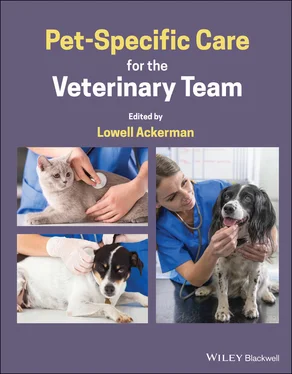In a simple world, as described earlier, one might consider the genome as a passenger train, with the genes as railway cars coupled to one another. In reality, it is not that orderly. This unsophisticated look is what provides an opportunity to learn a lot from the genome. If the genome were arranged like a train, researchers would have to isolate each gene (passenger car) to learn anything. Fortunately, however, nature has provided spacers, known as microsatellites, that can act as markers for traits. They might be considered as dining cars spaced between groups of passenger cars.
As more and more useful microsatellites are identified, a higher resolution map of the genome will continue to be developed of which markers are inherited along with specific genes. Then, by measuring these markers, we can tell with some accuracy an individual's genetic make‐up for that specific trait without having to necessarily identify the actual gene. This can be very helpful when trying to predict some disorders which are unlikely to be completely controlled by individual genes alone (e.g., hip dysplasia, atopic dermatitis, etc.).
To use the train example once more, when train cars are unhitched and transferred to other trains, which passenger cars always seem to go along with the same dining car? If you identify a specific dining car, you know which passenger cars are also likely to be found there, too. Obviously, the closer the gene (passenger car) is to the marker (dining car), the greater is the probability that the two will be transferred together. A gene that is farther away from the marker may not be transferred 100% of the time, which would affect a test's specificity and predictive ability. Thus, some microsatellite markers may be associated with increased risk of a condition, and others with decreased risk, and when considered in aggregate, they could provide an impression of the risk for such traits in individual animals.
Microsatellites have more to offer than just their role as signposts. They have considerable variability (which molecular geneticists call polymorphism ), making them unique identifiers of individuals and their offspring. Variations in a DNA sequence are called SNPs, some of which have no impact on health while others may predispose an individual to disease or signal responsiveness to medical therapies. Microsatellites are one way to identify an individual, as well as its progeny, and have become a voluntary part of the DNA identification for the different purebred registries. If a sire has six repetitive sequences relative to a specific marker and the dam has eight, the offspring will have one copy from each parent. By comparing findings at multiple markers, the accuracy of predicting parentage becomes a virtual certainty.
Short interspersed elements are often inserted within or near genes and may regulate their expression. The pet population has thousands of short interspersed element differences, which are associated with breed differences related to behavioral and physical characteristics and also act as signposts for specific genes linked to disease susceptibility or traits.
3.1.7 Predicting Genotype
Since alleles are inherited from both parents, it would be helpful to know how they combine in individuals and the impact that has on disease susceptibility. Two terms are important in this regard – genotype and phenotype.
Genotype refers to the actual genetic sequence determined in an animal, while phenotype describes what is clinically evident, compared to the normal or typical presentation. So, for any individual genetic trait (T), in which an animal could inherit a typical (T) or variant (t) gene from its parents, there are four combinations possible (TT, Tt, tT, tt) but really only three variants (TT, Tt, tt). If the condition is recessive (such as von Willebrand disease [vWD]) and the heterozygotes (Tt) cannot be clinically distinguished from one of the homozygotes (TT), then clinically there are three variants (TT, Tt, tt) but only two clinical phenotypes – normal (TT or Tt) and abnormal (tt). In the case of a recessive disorder like vWD, we have a genetic test that can tell us genotype (the actual gene pairing in the animal), but without the test we can only determine phenotype – normal versus abnormal, by evidence of bleeding factor tests. So, for a condition like hip dysplasia where currently we cannot identify genotype, we end up making the diagnosis with phenotypic tests such are radiographs or distraction index.
Progressive retinal atrophy in the Irish setter is inherited as an autosomal recessive trait, which means that an affected individual inherits a defective gene (rcd1) from each parent, whereas dogs that inherit a defective gene from only one parent may be difficult to identify, because they appear clinically normal. The good news for veterinary teams, even without a DNA test, is that an electroretinogram can identify affected individuals (with two copies of the abnormal gene) by 6 weeks of age. This identification means the dog can be removed from a breeding program so that it will not contribute its PRA genes to future generations. The bad news for veterinary teams and breeders is that carriers of the trait, those with only one abnormal variant and one normal variant, cannot be identified clinically, even with sophisticated procedures such as electroretinography. Therefore, without genetic testing, genetic counseling is a hit‐or‐miss enterprise until the animal produces affected offspring and we can determine its genotype. With direct DNA testing, though, animals that are affected, clear, or carriers can be identified (see 3.4Predicting and Eliminating Disease Traits).
That's good news for Labrador retriever breeders; labs are also prone to PRA but a clinical diagnosis cannot be made until the dogs are 4 years old, and an electroretinogram will not identify affected pups until they are 18 months old. DNA testing can identify status early, in pups as young as one day of age. Unfortunately, the specificity of DNA testing is also one of its limitations. The gene that causes PRA in Labrador retrievers (prcd) is different from the one that causes it in Irish setters (rcd1), so the same DNA test cannot be used to diagnose these two forms of the disease (and there are dozens of different genetic forms of PRA). Fortunately, DNA testing for both prcd and rcd1 is now available, and for many other forms of PRA.
3.1.8 Genetics Versus Genomics
There is a lot of attention focused on the promises of genomic medicine, and it can sometimes be confusing when we use the terms genetics and genomics synonymously. Genetics is the study of genes and how traits or conditions are passed from one generation to the next. On the other hand, genomics is the study of the entire genome, and its combined influence on complex diseases and the impact of environmental factors such as diet, exercise, medications, and toxins on genes.
3.1.9 The Impact of Breeding
With mass or individual selection, the breeder selects the animals to be bred on the basis of their superior characteristics. Whereas many breeders select their breeding stock on the basis of conformation or other physical characteristics that exemplify the breed standard, genetic counseling is intended to temper enthusiasm for physical traits with a more holistic picture of genotypic and phenotypic health (see 3.8Genetic Counseling). Veterinarians should also exert some self‐discipline by focusing not just on one health aspect (e.g., von Willebrand status) but rather on the whole animal. Otherwise, in the zeal to rid a line of one disease, another (or more) may inadvertently be fostered.
Selection works best at eliminating dominant traits from a population. After all, because all animals that carry the dominant allele develop the trait, it is theoretically possible to eliminate a dominant trait in one generation. Selection is complicated, however, by the fact that some dominant traits (e.g., dermatofibrosis) do not appear until later in life when animals may already have been bred, and by traits with incomplete dominance or variable expressivity, in which an affected animal may not be detected yet carry the trait. Fortunately, DNA testing is now available for some of these traits, including dermatofibrosis.
Читать дальше












